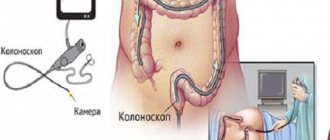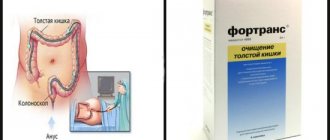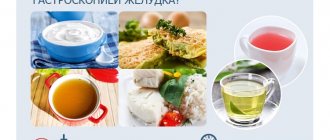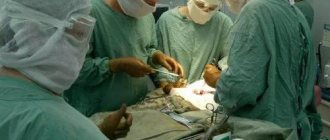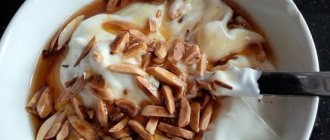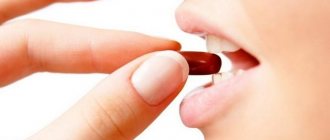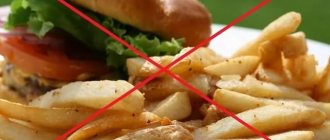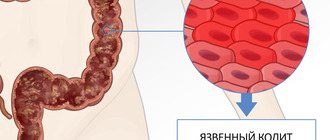General rules
The effectiveness of instrumental methods for examining various parts of the large intestine, in particular colonoscopy , and the timely diagnosis of pathology during their implementation are largely due to the quality of intestinal cleansing.
Despite the obviousness and understanding by patients of the importance of adequate preliminary bowel preparation, in practice, endoscopists quite often encounter poor visualization during colonoscopy, which is the reason for missing a pathological focus or neoplasms, as well as insufficiently accurate determination of the boundaries of its localization. A mandatory step in preparing the intestines and abdominal organs for examination ( colonoscopy , before MRI of the abdominal cavity, before ultrasound), as well as before intestinal surgery, is a slag-free diet. If the diet is not followed or carried out incorrectly, all efforts to prepare the intestines, even when taking the most effective oral medications, will not give the desired result.
What is a slag-free diet? This is a short-term therapeutic nutrition in which the diet includes foods and foods that create a minimum amount of solid excrement and promote the removal of feces from the body and maximum cleansing of the intestines from toxins.
When preparing for a colonoscopy, the main task is to maximally clean the intestinal lumen and mucous membrane from dense undigested food residues and mucus. At the same time, a waste-free diet before a colonoscopy not only cleanses the intestines, but also restores physiologically normal peristalsis, improves metabolism and overall well-being, since dietary nutrition also cleanses the body of waste and toxins . The diet, in most cases, is prescribed 3 days before the colonoscopy procedure, however, if there are a number of indications (anomalies of intestinal development, regular constipation ), the period can vary from 3 to 7 days.
Basic principles of the diet:
- The diet is unbalanced and physiologically inferior, so it can only be prescribed for a short period of time.
- The diet before intestinal colonoscopy should maximally maintain water balance and provide the body with vitamins , microelements and a small amount of energy.
- The food menu completely excludes indigestible foods that contain a lot of fiber or promote the development of fermentation processes in the intestines: stringy and fatty meats, sausages, fats, canned food, marinades, smoked foods, fresh vegetables, herbs and mushrooms. No legumes, coarse cereals, bran and rye bread, nuts, seeds, whole milk and dairy products, alcohol, and rye flour products are allowed.
- The diet is based on broths, lean dietary meat in small quantities, liquid soups, and cereals.
- Drinking regimen - 1.5-2.0 liters of free liquid per day.
- Products are steamed or boiled. It is forbidden to consume all fried foods, especially those with a crust.
- Excessively salty and spicy dishes and foods are excluded.
- Fractional meals in small portions.
- The day before the examination, you should switch completely to liquid nutrition: vegetable soups, tea with honey, juice diluted with water, low-fat yogurt/kefir.
Bowel restoration after colonoscopy
The most important stage for the recovery of the body after colonoscopy is dietary nutrition and maintaining water and electrolyte balance. After all, after a significant restriction in nutrition, cleansing the intestines with laxatives, a person is dehydrated and weakened. The first step to normalize the functioning of all organs and restore the intestinal microflora after colonoscopy is frequent and abundant drinking. Water, compote, vegetable broth, and fruit juices will help restore fluid.
The first day
On the first day after an intestinal colonoscopy, you should eat according to the example of a slag-free diet. The maximum you can snack on immediately after the procedure is yogurt or cheese without additives. Then meals should be taken every three hours.
The dishes consumed on this day may be the following:
- mashed potatoes or stewed vegetables,
- wholemeal bread or saltine crackers,
- steamed poultry cutlets or steamed fish,
- scrambled eggs or omelet,
- any fermented milk dishes,
- jelly,
- canned fruit without skin,
- water, tea, compote, juices.
Day two – seven
If the restoration of intestinal microflora after colonoscopy is progressing normally and you are not bothered by discomfort and pain, then you can gradually add foods to your diet, returning to your usual diet by the end of the week.
The procedure for adding dishes and products to your diet for a smooth exit from a slag-free diet is as follows:
- boiled or stewed vegetables,
- fruits and berries from compote and jelly,
- baked goods and bread products made from durum wheat flour,
- raw vegetables and fruits,
- nuts and seeds.
Exceptions
If, after a colonoscopy, minor inflammation of the intestinal tract occurs or minor injuries occur, the following products must be excluded from consumption on the first and second days after the procedure:
- alcohol,
- fried foods,
- tough meat,
- fatty foods,
- foods high in fiber.
Strictly restricting your diet will help stop inflammatory processes and promote better digestion of the food you consume. After all, a sharp increase in fiber will lead to bloating, pain and stool disorders, accompanied by constipation or diarrhea.
Rules
The diet after intestinal colonoscopy has a number of rules, compliance with which will only alleviate the general condition and normalize the functioning of the gastrointestinal tract.
- The total daily food intake should be divided into 5-7 meals.
- The break between meals should be 1.5-2 hours.
- A serving of food at one time should be 200-250 grams.
- All dishes should have a liquid and easily digestible consistency.
- The temperature of consumed food should vary between 15-55C.
- It is important to maintain water balance and drink a glass of water 30 minutes before meals and an hour after meals.
Important! You should not drink food with water right away, because... it blocks the creation of gastric juice.
Authorized Products
The diet menu allows lean broths and clear soups based on vegetables, chicken and beef meat, chicken meat, rabbit, turkey, lean fish, steamed (cod, pike perch, perch, pike), semolina and corn grits, eggs in the form of an omelet or soft-boiled, cheese, olive, sunflower and butter, white rice, premium wheat pasta, boiled and canned vegetables without peels and seeds (cucumbers, potatoes, carrots, mushrooms), fruit juice without pulp, ripe melon, peaches , apricots, purified non-carbonated drinking water, black and green tea, coffee without cream and milk, jelly, compotes without grounds, natural syrups and jellies, honey, dairy products (low-fat cottage cheese, yogurt without additives, kefir, skim milk), powdered without yeast dietary cookies (without fruit additives), crackers, white bread crackers.
Table of permitted products
| Proteins, g | Fats, g | Carbohydrates, g | Calories, kcal | |
Vegetables and greens | ||||
| canned eggplants | 0,9 | 0,7 | 7,3 | 49 |
| mashed potatoes | 2,5 | 4,2 | 14,7 | 106 |
| boiled carrots | 0,8 | 0,3 | 5,0 | 25 |
| canned cucumbers | 2,8 | 0,0 | 1,3 | 16 |
| boiled beets | 1,8 | 0,0 | 10,8 | 49 |
| canned tomatoes | 1,1 | 0,1 | 3,5 | 20 |
Fruits | ||||
| canned fruits | 0,5 | 0,1 | 9,5 | 40 |
| apricots | 0,9 | 0,1 | 10,8 | 41 |
| peaches | 0,9 | 0,1 | 11,3 | 46 |
Cereals and porridges | ||||
| buckwheat | 4,5 | 2,3 | 25,0 | 132 |
| semolina porridge on water | 2,5 | 0,2 | 16,8 | 80 |
| white boiled rice | 2,2 | 0,5 | 24,9 | 116 |
Flour and pasta | ||||
| premium boiled pasta | 3,5 | 0,4 | 23,2 | 112 |
| noodles | 12,0 | 3,7 | 60,1 | 322 |
| spaghetti | 10,4 | 1,1 | 71,5 | 344 |
Bakery products | ||||
| white bread crackers | 11,2 | 1,4 | 72,2 | 331 |
Confectionery | ||||
| jelly | 2,7 | 0,0 | 17,9 | 79 |
| cracker cookies | 11,3 | 13,4 | 67,1 | 352 |
Raw materials and seasonings | ||||
| honey | 0,8 | 0,0 | 81,5 | 329 |
| sugar | 0,0 | 0,0 | 99,7 | 398 |
Dairy | ||||
| dairy products | 3,2 | 6,5 | 4,1 | 117 |
Cheeses and cottage cheese | ||||
| cheese | 24,1 | 29,5 | 0,3 | 363 |
| cottage cheese 0.6% (low fat) | 18,0 | 0,6 | 1,8 | 88 |
Meat products | ||||
| boiled beef | 25,8 | 16,8 | 0,0 | 254 |
| veal | 19,7 | 1,2 | 0,0 | 90 |
Sausages | ||||
| boiled diet sausage | 12,1 | 13,5 | 0,0 | 170 |
Bird | ||||
| boiled chicken breast | 29,8 | 1,8 | 0,5 | 137 |
| boiled turkey fillet | 25,0 | 1,0 | — | 130 |
Eggs | ||||
| omelette | 9,6 | 15,4 | 1,9 | 184 |
| soft-boiled chicken eggs | 12,8 | 11,6 | 0,8 | 159 |
Fish and seafood | ||||
| boiled fish | 17,3 | 5,0 | 0,0 | 116 |
| zander | 19,2 | 0,7 | — | 84 |
| cod | 17,7 | 0,7 | — | 78 |
| pike | 18,4 | 0,8 | — | 82 |
Oils and fats | ||||
| vegetable oil | 0,0 | 99,0 | 0,0 | 899 |
| butter | 0,5 | 82,5 | 0,8 | 748 |
Non-alcoholic drinks | ||||
| green tea | 0,0 | 0,0 | 0,0 | — |
| black tea | 20,0 | 5,1 | 6,9 | 152 |
| hibiscus tea | 0,3 | 0,0 | 0,6 | 5 |
Juices and compotes | ||||
| apricot juice | 0,9 | 0,1 | 9,0 | 38 |
| jelly | 0,2 | 0,0 | 16,7 | 68 |
| Apple juice | 0,4 | 0,4 | 9,8 | 42 |
| * data is per 100 g of product | ||||
What to cook during a colonoscopy - recipes
We offer recipes for dishes that can be eaten before an intestinal colonoscopy. These are the best snack options that help reduce fiber intake and gently cleanse the intestines. Using the same recipes, you should also recover after the procedure, gradually adding familiar products to them.
Basic requirements for recipes:
- food should be liquid,
- dishes should not have solid particles,
- food consumed can only be warm or cold.
Compote and jelly - 2 in 1 recipe
A wonderful recipe for nutritious drinks that not only adults, but also children will enjoy drinking. In order to at least somehow diversify the diet before an intestinal colonoscopy, it is better to prepare dishes with different consistency from the same base.
Ingredients:
- Water – 3 l
- Dried apples – 150 gr
- Sugar – 4 tbsp. spoons
- Starch – 1 tbsp. spoon
Cooking method: boiling
Cuisine – European
Preparation time – 3 minutes
Cooking time – 30 minutes
Number of servings – compote and jelly, 1.5 l each
We prepare and measure the required amount of products.
Method for preparing compote
Rinse the dried apples well under running water several times.
Place the washed fruits in a saucepan with 3 liters of water. Bring water with dried fruits to a boil.
Add sugar to taste. Keep in mind that if you sweeten the compote with fruit, you will need more sugar. You can add sugar not now, but after you strain the fruit when it’s ready.
Turn the heat down to low and cook the apples for 20-30 minutes.
Strain the fruit and cool the infusion slightly before drinking.
Delicious and healthy apple compote is completely ready.
Method for making jelly
Pour half of the compote without fruit into a separate bowl and bring to a boil.
Mix sugar and cornstarch. If you use potato starch, you will need a little less of it.
Dilute sugar and starch with a small amount of water until it becomes a homogeneous liquid without lumps.
Pour the diluted starch into the compote in a thin stream with constant stirring.
Boil the mixture until slightly thickened.
Nutritious jelly is ready! Cool the mixture before using. To prevent the jelly from forming a thick film on top, you can cover it end-to-end with cling film or sprinkle it with powdered sugar.
Apple compote and jelly are an excellent opportunity to prepare the body for examination of the rectum. These same dishes will also help in restoring the intestines after colonoscopy, especially in the first days after the procedure.
Orange popsicle
The ability to have a tasty snack is one of the advantages of a liquid diet before a colonoscopy. Along with decoctions, teas, compotes and water, you should consume sorbet and fruit ice. If you were unable to buy blanks for fruit ice in the store, you can easily make it yourself at home.
Ingredients:
- Orange – 2 pcs.
- Apple juice – ½ cup
- Sugar - to taste
Cooking method
- Wash the citrus fruits thoroughly with a brush.
- Peel the juicy sweet oranges, removing the white layer as well.
- Cut the pulp into slices and place in a tall glass.
- Pour apple juice over everything.
- Add sugar to taste and dissolve it.
- Using an immersion blender, thoroughly beat the mixture until smooth.
- Pour the juice into disposable cups. Insert a popsicle stick or skewer into the center of each.
- Place in the freezer until completely frozen.
Advice.
If you want more flavorful ice, you can grate the zest on a fine grater and add it to the pulp and juice.
You can find another interesting multi-layer version of fruit ice in the video
Carrot puree
Liquid vegetable purees from potatoes, carrots or pumpkin are one of the important nutritional menu items before and after intestinal colonoscopy. They allow you to saturate the body without overloading the intestines.
Ingredients:
- Carrots – 1 kg
- Butter – 40 g
- Salt - to taste
Cooking method
- Peel the carrots and wash thoroughly. Cut the root vegetable into large slices.
- Place the carrots in a saucepan, add water and bring to a boil.
- Salt the water to taste, turn down the heat and cook until the root vegetable is soft for about 20 minutes.
- Drain off excess water and add a little butter to the hot mixture.
- Using a masher, puree the carrots until smooth. Adjust the consistency of the mass with the water in which the carrots were cooked.
Advice.Because There is no starch in carrots, so this puree cannot be diluted with milk or cream, otherwise the dish will separate later.
- At the end, season the dish again with salt and pepper to taste.
Green tea jelly
A little unusual, but healthy and tasty dessert. It has a positive effect on the microflora not only before colonoscopy, but also during normal times.
Ingredients:
- Green tea – 400 ml
- Honey – 50 g
- Gelatin – 10 g
Cooking method
- Prepare green tea in any convenient way. But if you want to make it incredibly tasty, then see the link for how to brew it correctly
- Soak the gelatin in water and leave for 10-12 minutes to swell.
- Then heat the gelatin in a water bath.
- Strain the tea through a sieve to prevent tea leaves from getting into the dessert.
- Add honey and dilute it in tea until dissolved.
- Heat the tea until the honey is completely dissolved and add the diluted gelatin.
- Mix everything carefully and pour into molds.
- Place the jelly in the refrigerator until completely cooled.
Homemade yogurt
A diet before colonoscopy is not complete without natural yogurt. And the rapid restoration of microflora after the procedure also depends on this product. To ensure that healthy yogurt is always at hand, it is better to prepare it yourself, even without a yogurt maker.
Ingredients:
- Milk – 1 l
- Natural yogurt – 1 tbsp. spoon
Cooking method
- Heat the milk until it boils, ideally up to 80C. It is better to use natural homemade milk as a base for yogurt. If you buy store-bought, then take only pasteurized.
- Remove the foam from hot milk every time. how she appears.
- Pour the milk into a glass container. It is important to note that glass containers are needed to make yogurt.
- Cool the milk to 38-45M. If you don’t have a thermometer, you can measure the temperature with your finger - if you can bear it, then the temperature is appropriate.
- As a starter, add a spoonful of natural yogurt without dye, flavor, or fruit additives. Stir it thoroughly, distributing it throughout the milk.
- Cover the dish with a lid or place in a warm place. You can also wrap it in a towel for 6-8 hours.
- The finished yogurt may have some whey on top. It can be drained or mixed with the whole mass.
You can find another step-by-step recipe with a photo of making yogurt without a yogurt maker here .
Fully or partially limited products
Fatty meats, smoked sausages, animal fats, marinades, canned food, smoked foods, any raw vegetables and root vegetables (cabbage, carrots, radishes, beets, turnips, onions, garlic) are completely excluded from the diet; fatty fish, greens (spinach, sorrel); coarse porridge (barley, oatmeal, millet); mushrooms, legumes (lentils, peas, beans, beans), as they cause increased gas formation in the intestines; rye bread and products made from rye flour; fruits (pear, bananas, tangerines, peach, apple, grapes); all types of nuts and dried fruits; any berries; whole milk and dairy products (except fermented milk).
It is not allowed to include chocolate, cocoa, any pastries and sweets, confectionery (cakes, cookies, candies, pastries), carbonated drinks, juices with pulp and nectars in packages, and seasonings in the diet. Drinking any drinks containing alcohol is prohibited.
Table of prohibited products
| Proteins, g | Fats, g | Carbohydrates, g | Calories, kcal | |
Vegetables and greens | ||||
| beans | 6,0 | 0,1 | 8,5 | 57 |
| peas | 6,0 | 0,0 | 9,0 | 60 |
| broccoli | 3,0 | 0,4 | 5,2 | 28 |
| Brussels sprouts | 4,8 | 0,0 | 8,0 | 43 |
| cauliflower | 2,5 | 0,3 | 5,4 | 30 |
| bulb onions | 1,4 | 0,0 | 10,4 | 41 |
| carrot | 1,3 | 0,1 | 6,9 | 32 |
| radish | 1,2 | 0,1 | 3,4 | 19 |
| white radish | 1,4 | 0,0 | 4,1 | 21 |
| turnip | 1,5 | 0,1 | 6,2 | 30 |
| beans | 7,8 | 0,5 | 21,5 | 123 |
| horseradish | 3,2 | 0,4 | 10,5 | 56 |
| garlic | 6,5 | 0,5 | 29,9 | 143 |
Fruits | ||||
| oranges | 0,9 | 0,2 | 8,1 | 36 |
| bananas | 1,5 | 0,2 | 21,8 | 95 |
| cherry | 0,8 | 0,5 | 11,3 | 52 |
| grapefruit | 0,7 | 0,2 | 6,5 | 29 |
| lemons | 0,9 | 0,1 | 3,0 | 16 |
| apples | 0,4 | 0,4 | 9,8 | 47 |
Berries | ||||
| grape | 0,6 | 0,2 | 16,8 | 65 |
| currant | 1,0 | 0,4 | 7,5 | 43 |
Mushrooms | ||||
| mushrooms | 3,5 | 2,0 | 2,5 | 30 |
Nuts and dried fruits | ||||
| nuts | 15,0 | 40,0 | 20,0 | 500 |
| dried fruits | 2,3 | 0,6 | 68,2 | 286 |
| raisin | 2,9 | 0,6 | 66,0 | 264 |
Snacks | ||||
| potato chips | 5,5 | 30,0 | 53,0 | 520 |
| salted popcorn | 7,3 | 13,5 | 62,7 | 407 |
Cereals and porridges | ||||
| porridge with milk | 3,3 | 2,9 | 17,4 | 105 |
| oat bran | 8,0 | 4,0 | 10,0 | 110 |
| pearl barley porridge | 3,1 | 0,4 | 22,2 | 109 |
| millet porridge | 4,7 | 1,1 | 26,1 | 135 |
| boiled brown rice | 2,6 | 0,9 | 22,8 | 110 |
| barley porridge | 11,5 | 2,0 | 65,8 | 310 |
| rye bran | 11,2 | 3,2 | 32,0 | 221 |
Flour and pasta | ||||
| pancakes | 6,1 | 12,3 | 26,0 | 233 |
| vareniki | 7,6 | 2,3 | 18,7 | 155 |
| dumplings | 11,9 | 12,4 | 29,0 | 275 |
Bakery products | ||||
| loaf with wheat bran | 9,2 | 2,8 | 51,4 | 273 |
| buns | 7,9 | 9,4 | 55,5 | 339 |
| rye-wheat bread | 8,1 | 3,4 | 42,2 | 222 |
Confectionery | ||||
| candies | 4,3 | 19,8 | 67,5 | 453 |
| cake | 3,8 | 22,6 | 47,0 | 397 |
| halva | 11,6 | 29,7 | 54,0 | 523 |
Cakes | ||||
| cake | 4,4 | 23,4 | 45,2 | 407 |
Chocolate | ||||
| chocolate | 5,4 | 35,3 | 56,5 | 544 |
Raw materials and seasonings | ||||
| seasonings | 7,0 | 1,9 | 26,0 | 149 |
| mayonnaise | 2,4 | 67,0 | 3,9 | 627 |
Dairy | ||||
| milk | 3,2 | 3,6 | 4,8 | 64 |
| condensed milk | 7,2 | 8,5 | 56,0 | 320 |
Meat products | ||||
| pork | 16,0 | 21,6 | 0,0 | 259 |
| salo | 2,4 | 89,0 | 0,0 | 797 |
Sausages | ||||
| smoked sausage | 28,2 | 27,5 | 0,0 | 360 |
Bird | ||||
| duck | 16,5 | 61,2 | 0,0 | 346 |
| goose | 16,1 | 33,3 | 0,0 | 364 |
Fish and seafood | ||||
| pink salmon | 20,5 | 6,5 | 0,0 | 142 |
| Red caviar | 32,0 | 15,0 | 0,0 | 263 |
| salmon | 19,8 | 6,3 | 0,0 | 142 |
| seaweed | 0,8 | 5,1 | 0,0 | 49 |
| fish balyk | 20,4 | 12,5 | 0,0 | 194 |
| herring | 16,3 | 10,7 | — | 161 |
| salmon | 21,6 | 6,0 | — | 140 |
Oils and fats | ||||
| animal fat | 0,0 | 99,7 | 0,0 | 897 |
| cooking fat | 0,0 | 99,7 | 0,0 | 897 |
Alcoholic drinks | ||||
| dry white wine | 0,1 | 0,0 | 0,6 | 66 |
| red dessert wine | 0,5 | 0,0 | 20,0 | 172 |
| whiskey | 0,0 | 0,0 | 0,4 | 235 |
| vodka | 0,0 | 0,0 | 0,1 | 235 |
| cognac | 0,0 | 0,0 | 0,1 | 239 |
| liquor | 0,3 | 1,1 | 17,2 | 242 |
| beer | 0,3 | 0,0 | 4,6 | 42 |
Non-alcoholic drinks | ||||
| cola | 0,0 | 0,0 | 10,4 | 42 |
| sprite | 0,1 | 0,0 | 7,0 | 29 |
| tonic | 0,0 | 0,0 | 8,3 | 34 |
| Fanta | 0,0 | 0,0 | 11,7 | 48 |
| energy drink | 0,0 | 0,0 | 11,3 | 45 |
Juices and compotes | ||||
| grape juice | 0,3 | 0,0 | 14,0 | 54 |
| * data is per 100 g of product | ||||
Slag-free diet menu before intestinal colonoscopy (Diet)
The menu before intestinal colonoscopy includes any permitted products and depends on the duration of the diet. Meals are fractional, in small portions.
Sample menu of a slag-free diet for a week:
7-4 days before colonoscopy
| Breakfast |
|
| Snack |
|
| Dinner |
|
| Dinner |
|
3-2 days before colonoscopy
| Breakfast |
|
| Snack |
|
| Dinner |
|
| Dinner |
|
1 day before colonoscopy
| Breakfast |
|
| Snack |
|
| Dinner |
|
| Dinner |
|
Quitting the diet
After successful completion of the procedure, exit from the slag-free diet should be carried out gradually over 5-7 days. If the rules for leaving the diet are not followed and fatty meat products and root vegetables are quickly included in the diet, there is a danger of constipation and fecal stones.
Therefore, expand your diet after the examination gradually, filling it first with foods that are easily digested in the intestines (cereals, vegetables, fruits), and then, if you feel normal, introduce fatty meats and other previously prohibited foods. Don't forget to drink plenty of fluids. probiotics after a colonoscopy to normalize the microflora of the gastrointestinal tract , which will also help improve digestion.
Diet after the procedure
Food should be easily digestible and consist of fruits, vegetables, fish, and dietary meat. For a couple more days you should refrain from eating baked goods, canned foods, whole grain porridges, and smoked meats. The diet should include dishes made from low-fat fish, yogurt, low-fat cottage cheese, milk, and kefir.
After a colonoscopy, it is very important to go off the diet correctly. To prevent overeating, the patient must gradually increase portions and add foods that were prohibited during the diet.
Comments from nutritionists
The diet in preparation for an intestinal examination can be called strict and unbalanced, since it excludes the consumption of sufficient quantities of various foods that provide the body with the necessary amount of energy, proteins, fats, and carbohydrates.
In this regard, many patients in the first days may feel dizzy , general malaise, and experience acute attacks of hunger. To make life as easy as possible during this period, do not allow heavy physical activity and avoid stressful situations. Try to reduce the intensity of work during this period and interrupt sports activities. Do not schedule a colonoscopy during periods of intense brain activity (sessions, presentations at work) that require careful preparation.
Many believe that this “low-slag” diet can be used for other purposes, in particular to cleanse the body of waste and toxins . This is a misconception. This food is intended directly to prepare the intestines for the examination. And the “slagging” of the body must be reduced by other types of diets, in particular, by holding regular (2-3 times a week) fasting days (kefir, vegetable, cottage cheese), as well as special types of body cleansing, for example, a Russian/Finnish bath.
Results and reviews
Since a slag-free diet in preparation for colonoscopy is mandatory, patient reviews differ mainly in tolerability, and its results are directly determined by the creation of conditions for conducting a high-quality examination of the intestines.
- “... When I suspected an intestinal tumor, I was prescribed a colonoscopy and a slag-free diet 5 days before the examination. I ate only what I could eat and didn’t allow myself anything extra. For me these were painful days - a strong and constant feeling of hunger, a headache, I could not do anything. I could hardly stand it, but the doctor said that I was well prepared for the examination”;
- “... A sigmoidoscopy was prescribed. Before the sigmoidoscopy, the doctor advised me to go on a 1-2 day diet with the exclusion of foods that cause increased gas formation in the intestines and to do a high-quality cleansing enema. The examination went well."
Video “Colonoscopy: questions and answers”
Answers to frequently asked questions regarding colonoscopy are presented in the following video from the European Clinic channel.
Do you have any questions? Specialists and readers of the HROMOSOMA website will help you ask a question
Was this article helpful?
Thank you for your opinion!
The article was useful. Please share the information with your friends.
Yes (100.00%)
No
X
Please write what is wrong and leave recommendations on the article
Cancel reply
Rate the benefit of the article: Rate the author ( 2 votes, average: 5.00 out of 5)
Discuss the article:
